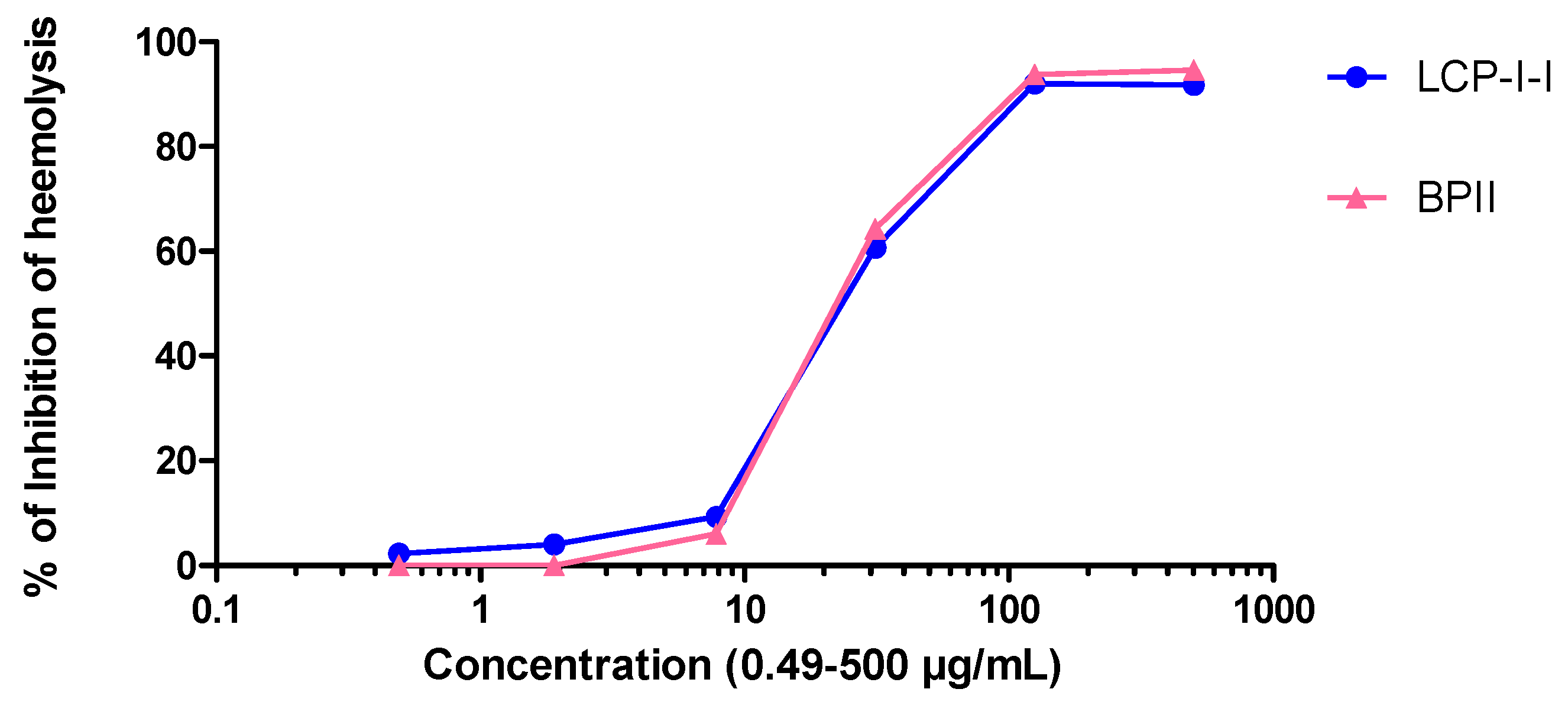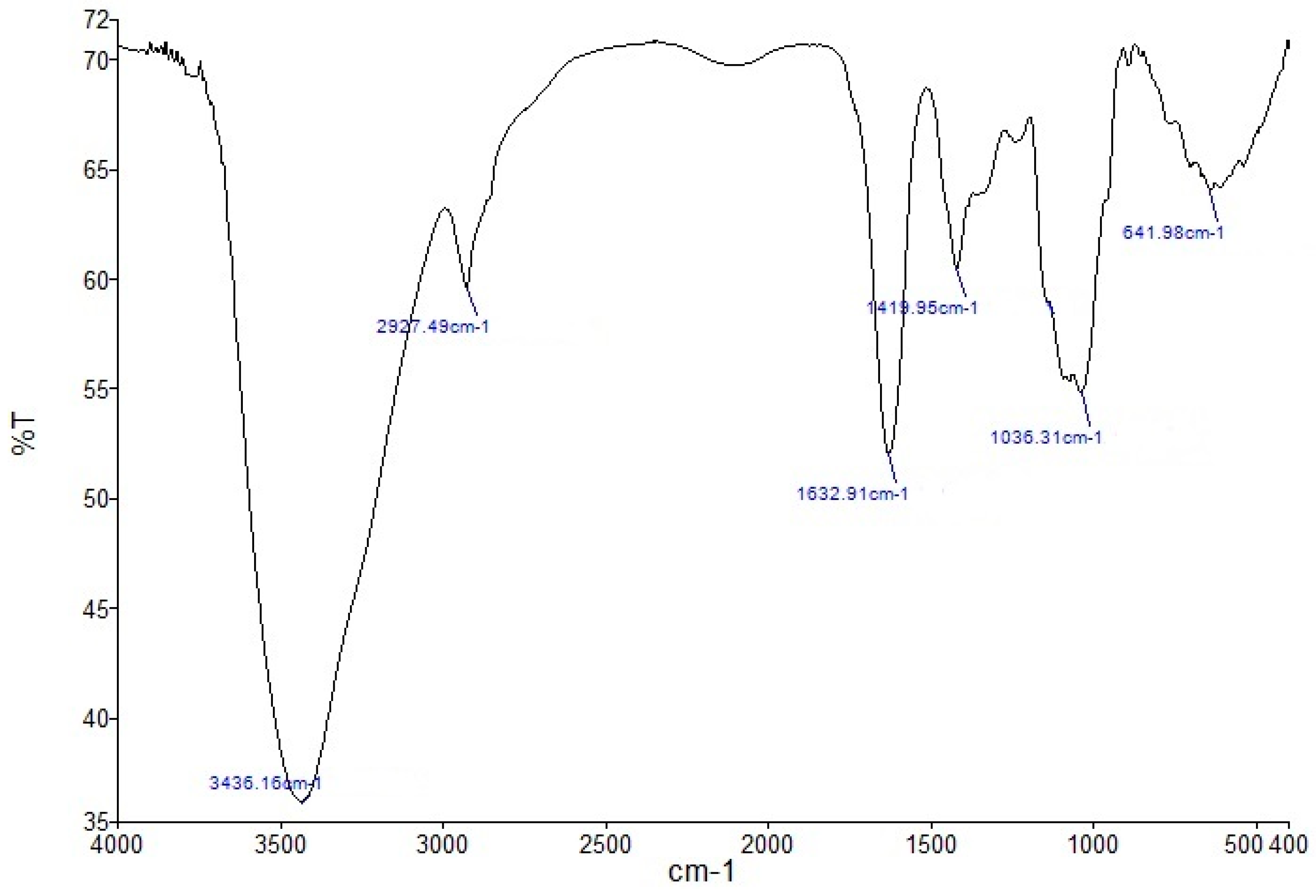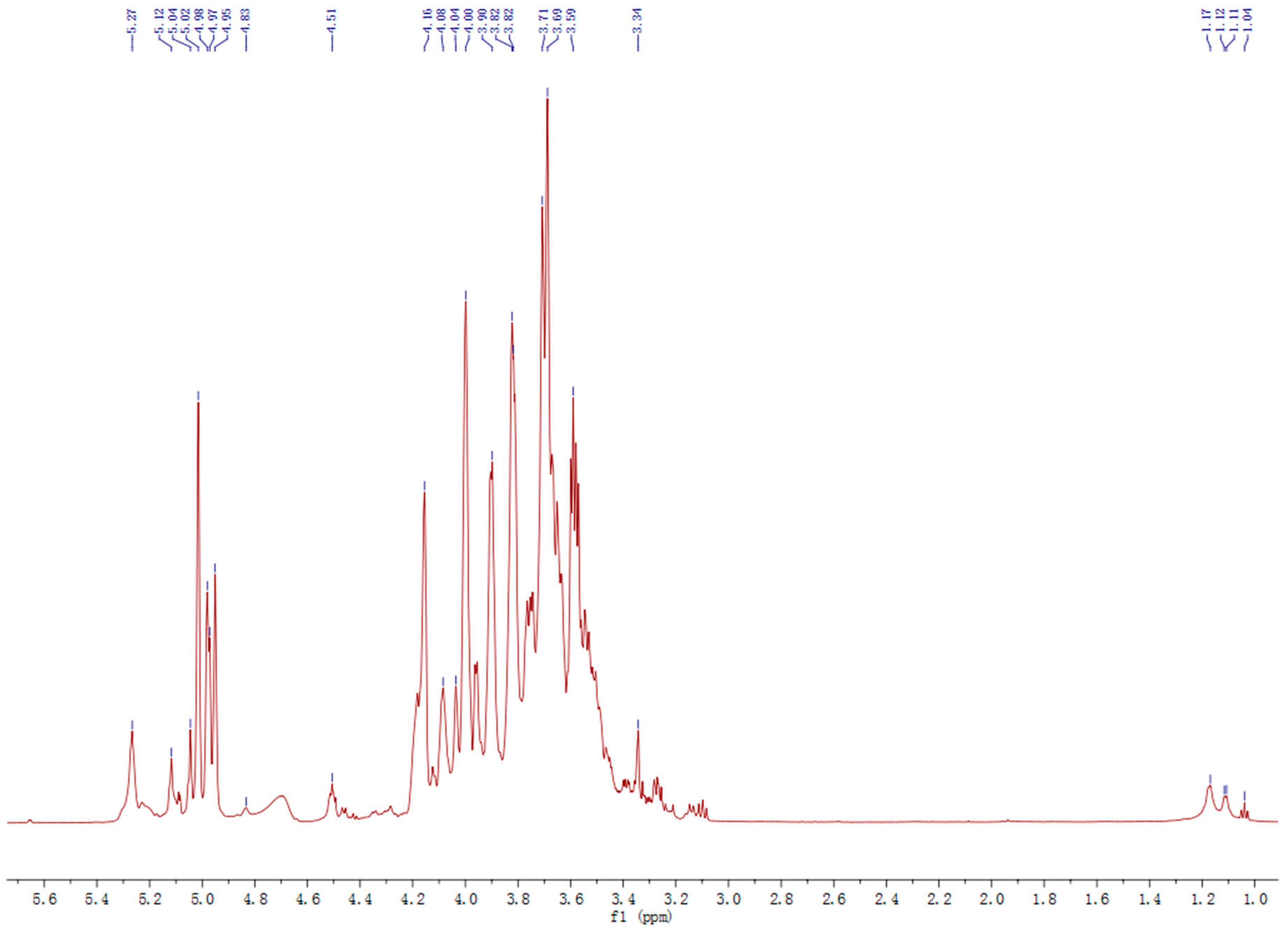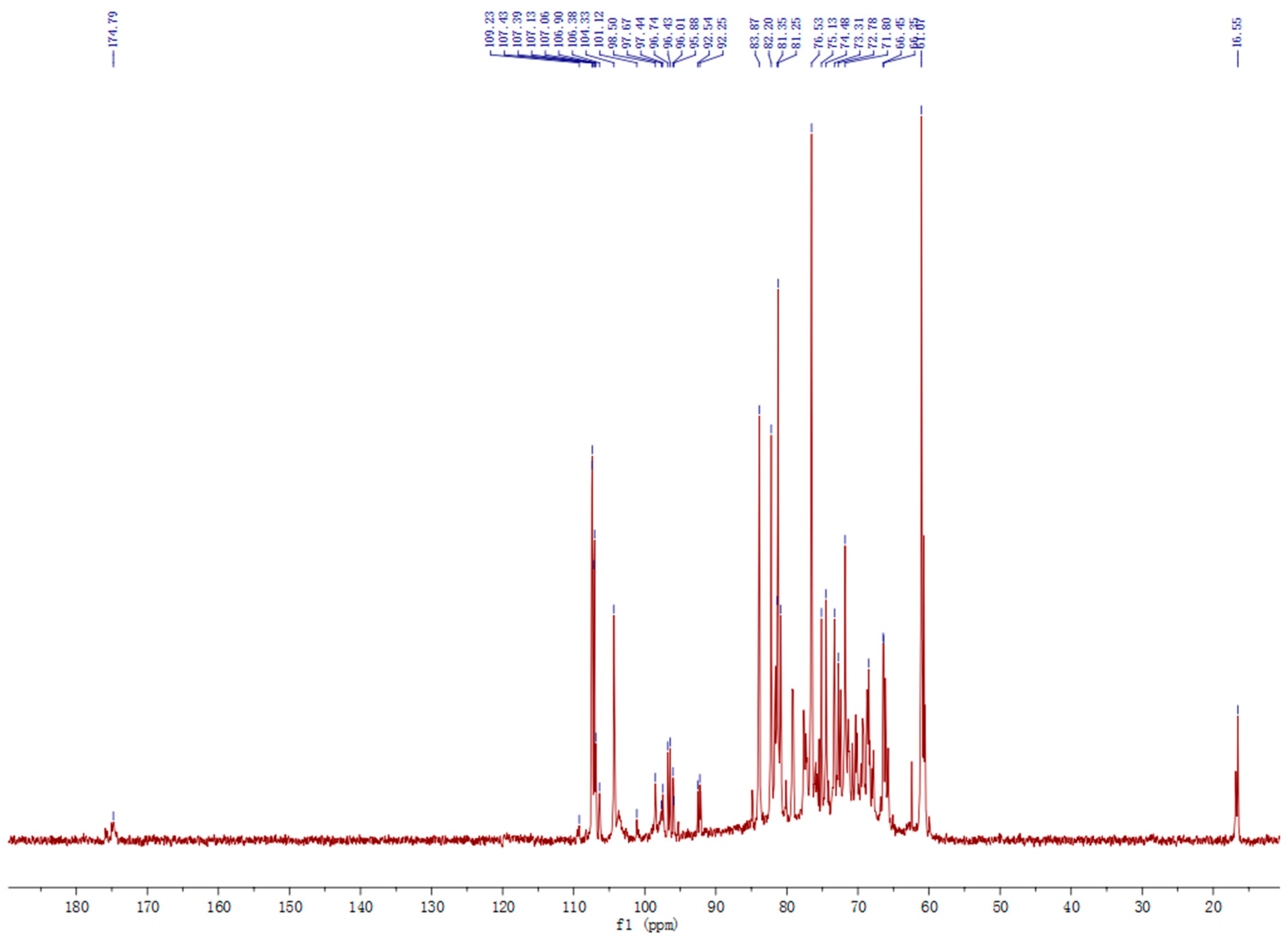Purification and Partial Structural Characterization of a Complement Fixating Polysaccharide from Rhizomes of Ligusticum chuanxiong
Abstract
:1. Introduction
2. Results and Discussion
2.1. Extraction and Fractionation of Polysaccharide Fractions
2.2. Complement Fixation Activity
2.3. Chemical Composition of Polysaccharide LCP-I-I
2.4. Determination of Glycosidic Linkages in LCP-I-I
2.5. Other Structural Features
3. Materials and Methods
3.1. Plant Material
3.2. Extraction of Polysaccharides
3.3. Complement Fixation Assay
3.4. Chemical Compositions
3.5. Linkage Determination
3.6. Molecular Weight Determination
3.7. FT-IR and NMR Spectroscopy
4. Conclusions
Acknowledgments
Author Contributions
Conflicts of Interest
References
- Wagner, H.; Bauer, R.; Melchart, D.; Xiao, P.G.; Staudinger, A. Chromatographic Fingerprint Analysis of Herbal Medicines: Thin-Layer and High Performance Liquid Chromatography of Chinese Drugs, 2nd ed.; Springer: Wien, Austria; New York, NY, USA; Berlin, Germany, 2011; Volume 1, pp. 181–190. [Google Scholar]
- Yuan, J.F.; Zhang, Z.Q.; Fan, Z.C.; Yang, J.X. Antioxidant effects and cytotoxicity of three purified polysaccharides from Ligusticum chuanxiong Hort. Carbohydr. Polym. 2008, 74, 822–827. [Google Scholar] [CrossRef]
- Huang, J.; Lu, X.Q.; Zhang, C.; Lu, J.; Li, G.Y.; Lin, R.C.; Wang, J.H. Anti-inflammatory ligustilides from Ligusticum chuanxiong Hort. Fitoterapia 2013, 91, 21–27. [Google Scholar] [CrossRef] [PubMed]
- Chan, S.S.; Choi, A.O.; Jones, R.L.; Lin, G. Mechanisms underlying the vasorelaxing effects of butylidenephthalide, an active constituent of Ligusticum chuanxiong, in rat isolated aorta. Eur. J. Pharmacol. 2006, 537, 111–117. [Google Scholar] [CrossRef] [PubMed]
- Jeong, J.B.; Ju, S.Y.; Park, J.H.; Lee, J.R.; Yun, K.W.; Kwon, S.T.; Lim, J.H.; Chung, G.Y.; Jeong, H.J. Antioxidant activity in essential oils of Cnidium officinale makino and Ligusticum chuanxiong hort and their inhibitory effects on DNA damage and apoptosis induced by ultraviolet B in mammalian cell. Cancer Epidemiol. 2009, 33, 41–46. [Google Scholar] [CrossRef] [PubMed]
- Xia, R.; Ma, L.; Peng, C.; Zhang, H.; Qin, L.P. Ligusticum chuanxiong Hort: A review of chemistry and pharmacology. Pharm. Biol. 2011, 49, 1180–1189. [Google Scholar]
- Li, S.L.; Yan, R.; Tam, Y.K.; Lin, G. Post-harvest alteration of the main chemical ingredients in Ligusticum chuanxiong Hort. (Rhizoma Chuanxiong). Chem. Pharm. Bull. 2007, 55, 140–144. [Google Scholar] [CrossRef] [PubMed]
- Li, W.; Tang, Y.; Chen, Y.; Duan, J.A. Advances in the chemical analysis and biological activities of Chuanxiong. Molecules 2012, 17, 10614–10651. [Google Scholar] [CrossRef] [PubMed]
- Fan, Z.C.; Zhang, Z.Q. Extraction, purification and anti-oxidative activities of polysaccharides from Ligusticum chuanxiong Hort. Nat. Prod. Res. Dev. 2005, 17, 561–567. [Google Scholar]
- Wang, J.C.; Liu, W.; Yang, R.L.; Sun, X.B. Influence of Chuanxiong polysaccharides on proliferation and apoptosis of human hepatoma cell HepG2. J. Nanjing Univ. Tradit. Chin. Med. 2014, 5, 461–464. [Google Scholar]
- Liu, J.L.; Zheng, S.L.; Fan, Q.J.; Yuan, J.C.; Yang, S.M.; Kong, F.L. Optimisation of high-pressure ultrasonic-assisted extraction and antioxidant capacity of polysaccharides from the rhizome of Ligusticum chuanxiong. Int. J. Biol. Macromol. 2015, 76, 80–85. [Google Scholar] [CrossRef] [PubMed]
- Zhang, W.J.; Wang, P.; Yang, M.J.; Wang, Y.G.; Ju, Y.; Du, R.H. Analysis and comparison of polysaccharide activity of chuanxiong and chishao. J. Chin. Med. Mater. 2011, 34, 1569–1574. [Google Scholar]
- Huang, H.F.; Wang, W.X. Extraction of polysaccharides from Ligusticum chuanxiong hort by microwave-assisted method. Lishizhen Med. Mater. Med. Res. 2009, 20, 2734–2735. [Google Scholar]
- Li, L.; Wang, W.X.; Wang, X.J. Study of the pectinase extraction process of Chuanxiong polysaccharide. J. Chin. Med. Mater. 2008, 31, 600–602. [Google Scholar]
- Sun, X.; Wang, W.X. Extraction of polysaccharides from Ligusticum chuanxiong hort by cellulose enzyme method. J. Xihua Univ. (Nat. Sci. Ed.) 2009, 28, 103–106. [Google Scholar]
- Xiang, M.; Wang, X.J.; Wang, W.X. Optimization of the ultrasonic extraction process of Chuanxiong polysaccharide. Chin. Tradit. Pat. Med. 2008, 30, 1621–1623. [Google Scholar]
- Sun, X.C.; Yan, J.; He, G.; Zhang, L.L.; Yi, Y.; Gou, X.J. Purification and analysis of monosaccharide composition of Ligusticum chuanxiong polysaccharide. J. Sichuan Agric. Univ. 2011, 29, 56–60. [Google Scholar]
- Fan, Z.C.; Zhang, Z.Q. Polysaccharides from Ligusticum chuanxiong. Chin. Tradit. Herb. Drugs 2006, 37, 973–976. [Google Scholar]
- Dunkelberger, J.R.; Song, W.C. Complement and its role in innate and adaptive immune responses. Cell Res. 2010, 20, 34–50. [Google Scholar] [CrossRef] [PubMed]
- Waldron, K.W.; Faulds, C.B. Cell Wall Polysaccharides: Composition and Structure. In Comprehensive Glycoscience—From Chemistry to Systems Biology; Kamerling, J.P., Boons, G.J., Lee, Y.C., Suzuki, A., Taniguchi, N., Voragen, A.G.J., Eds.; Elsevier: Oxford, UK, 2007; Volume 1, pp. 181–201. [Google Scholar]
- Ridley, B.L.; O’Neill, M.A.; Mohnen, D. Pectins: Structure, biosynthesis, and oligogalacturonide-related signaling. Phytochemistry 2001, 57, 929–967. [Google Scholar] [CrossRef]
- Van Holst, G.J.; Clarke, A.E. Quantification of arabinogalactan-protein in plant extracts by single radial gel diffusion. Anal. Biochem. 1985, 148, 446–450. [Google Scholar] [CrossRef]
- Hinz, S.W.A.; Verhoef, R.; Schols, H.A.; Vincken, J.-P.; Og Voragen, A.G.J. Type I arabinogalactan contains β-d-Galp-(1→3)-β-d-Galp structural elements. Carbohydr. Res. 2005, 340, 2135–2143. [Google Scholar] [CrossRef] [PubMed]
- Hunter, R.A.; McIntyre, B.L.; McIlroy, R.J. Water-soluble carbohydrates of tropical pasture grasses and legumes. J. Sci. Food. Agric. 1970, 21, 400–405. [Google Scholar] [CrossRef]
- Liu, X.C.; Zhu, Z.Y.; Tang, Y.L.; Wang, M.F.; Wang, Z.; Liu, A.J.; Zhang, Y.M. Structural properties of polysaccharides from cultivated fruit bodies and mycelium Corduceps militaris. Carbohydr. Polym. 2016, 142, 63–72. [Google Scholar] [CrossRef] [PubMed]
- Mustafa, C. Vibrational spectroscopy of pyrogallol with a glance on the problems of formation of a dimer. Res. J. Chem. Environ. 2013, 17, 117–128. [Google Scholar]
- Chai, Y.Y.; Zhao, M. Purification, characterization and anti-proliferation activities of polysaccharides extracted from Viscum coloratum (Kom.) Nakai. Carbohydr. Polym. 2016, 149, 121–130. [Google Scholar] [CrossRef] [PubMed]
- Kačuráková, M.; Capek, P.; Sasinková, V.; Wellner, N.; Ebringerová, A. FT-IR study of plant cell wall model compounds: Pectic polysaccharides and hemicelluloses. Carbohydr. Polym. 2000, 43, 195–203. [Google Scholar] [CrossRef]
- Ho, G.T.T.; Zou, Y.F.; Aslaksen, T.H.; Wangensteen, H.; Barsett, H. Structural characterization of bioactive pectic polysaccharides from elderflowers (Sambuci flos). Carbohydr. Polym. 2016, 135, 128–137. [Google Scholar] [CrossRef] [PubMed]
- Zhang, H.; Nie, S.P.; Yin, J.Y.; Wang, Y.X.; Xie, M.Y. Structural characterization of a heterogalactan purified from fruiting bodies of Ganoderma atrum. Food Hydrocolloids 2014, 36, 339–347. [Google Scholar] [CrossRef]
- Zhang, Q.; Xu, Y.; Zou, S.; Zhang, X.D.; Cao, K.; Fan, Q. Novel functional polysaccharides from Radix Polygoni Multiflori water extracted residue: Preliminary characterization and immunomodulatory activity. Carbohydr. Polym. 2016, 137, 625–631. [Google Scholar] [CrossRef] [PubMed]
- Shakhmatov, E.G.; Toukach, P.V.; Michailowa, E.A.; Makarova, E.N. Structural studies of arabinan-rich pectic polysaccharides from Abies sibirica L. biological activity of pectins of A. sibirica. Carbohydr. Polym. 2014, 113, 515–524. [Google Scholar] [CrossRef] [PubMed]
- Hromádková, Z.; Košt’álová, Z.; Vrchotová, N.; Ebringerová, A. Non-cellulosic polysaccharides from the leaves of small balsam (Impatiens parviflora DC.). Carbohydr. Res. 2014, 389, 147–153. [Google Scholar]
- Košt’álová, Z.; Hromádková, Z.; Ebringerová, A. Structural diversity of pectins isolated from the Styrian oil-pumpkin (Cucurbita pepo var. styriaca) fruit. Carbohydr. Polym. 2013, 93, 163–171. [Google Scholar]
- Li, J.; Fan, L.; Ding, S. Isolation, purification and structure of a new water-soluble polysaccharide from Zizyphus jujuba cv. Jinsixiaozao. Carbohydr. Polym. 2011, 83, 477–482. [Google Scholar] [CrossRef]
- Zou, Y.F.; Chen, X.F.; Malterud, K.E.; Rise, F.; Barsett, H.; Inngjerdingen, K.T.; Michaelsen, T.E.; Paulsen, B.S. Structural features and complement fixing activity of polysaccharides from Codonopsis pilosula Nannf. var. modesta L.T. Shen roots. Carbohydr. Polym. 2014, 113, 420–429. [Google Scholar] [CrossRef] [PubMed]
- Huang, F.; Zhang, R.F.; Liu, Y.; Xiao, J.; Su, D.X.; Yi, Y.; Wang, G.J.; Wei, Z.C.; Zhang, M.W. Characterization and mesenteric lymph node cells-mediated immunomodulatory activity of litchi pulp polysaccharide fractions. Carbohydr. Polym. 2016, 152, 496–503. [Google Scholar] [CrossRef] [PubMed]
- Austarheim, I.; Christensen, B.E.; Hegna, I.K.; Petersen, B.O.; Duus, J.O.; Bye, R.; Michaelsen, T.E.; Diallo, D.; Inngjerdingen, M.; Paulsen, B.S. Chemical and biological characterization of pectin-like polysaccharides from the bark of the Malian medicinal tree Cola cordifolia. Carbohydr. Polym. 2012, 89, 259–268. [Google Scholar] [CrossRef] [PubMed]
- Dubois, M.; Gilles, K.A.; Hamilton, J.K.; Rebers, P.A.; Smith, F. Colorimetric method for determination of sugars and related substances. Anal. Chem. 1956, 28, 350–356. [Google Scholar] [CrossRef]
- Michaelsen, T.E.; Gilje, A.; Samuelsen, A.B.; Hagasen, K.; Paulsen, B.S. Interaction between human complement and a pectin type polysaccharide fraction, PMII, from the leaves of Plantago major L. Scand. J. Immunol. 2000, 52, 483–490. [Google Scholar] [CrossRef] [PubMed]
- Grønhaug, T.E.; Kiyohara, H.; Sveaass, A.M.; Diallo, D.; Yamada, H.; Paulsen, B.S. Beta-d-(1→4)-galactan-containing side chains in RG-I regions of pectic polysaccharides from Biophytum petersianum Klotzsch contribute to expression of immunomodulating activity against intestinal Peyer’s patch cells and macrophages. Phytochemistry 2011, 72, 2139–2147. [Google Scholar] [CrossRef] [PubMed]
- Chambers, R.E.; Clamp, J.R. Assessment of methanolysis and other factors used in the analysis of carbohydrate-containing materials. Biochem. J. 1971, 125, 1009–1018. [Google Scholar] [CrossRef] [PubMed]
- Singleton, V.L.; Rossi, J.A. Colorimetry of Total Phenolics with Phosphomolybdic-phosphotungstic acid reagents. Am. J. Enol. Viticult. 1965, 37, 144–158. [Google Scholar]
- Bradford, M.M. A rapid and sensitive method for the quantification of microgram quantities of protein utilizing the principle of protein-dye binding. Anal. Biochem. 1976, 72, 248–254. [Google Scholar] [CrossRef]
- Kim, J.B.; Carpita, N.C. Changes in esterification of the uronic-acid groups of cell-wall polysaccharides during elongation of maize coleoptiles. Plant. Physiol. 1992, 98, 646–653. [Google Scholar] [CrossRef] [PubMed]
- Sweet, D.P.; Shapiro, R.H.; Albersheim, P. Quantitative analysis by various GLC response-factor theories for partially methylated and partially ethylated alditol acetates. Carbohydr. Res. 1975, 40, 217–225. [Google Scholar] [CrossRef]
- Zhu, Z.Y.; Liu, R.Q.; Si, C.L.; Zhou, F.; Wang, Y.X.; Ding, L.N.; Jing, C.; Liu, A.J.; Zhang, Y.M. Structural analysis and anti-tumor activity comparison of polysaccharides from Astragalus. Carbohydr. Polym. 2011, 85, 895–902. [Google Scholar] [CrossRef]
- Yan, J.K.; Li, L.; Wang, Z.M.; Wu, J.Y. Structural elucidation of an exopolysaccharide from mycelial fermentation of a Tolypocladium sp. fungus isolated from wild Cordyceps sinensis. Carbohydr. Polym. 2010, 79, 125–130. [Google Scholar] [CrossRef]
- Sample Availability: Samples of the compounds LCP-I-I are available from the authors.





| LCP-I-I | |
|---|---|
| Ara a | 28.5 |
| Rha a | 5.9 |
| Xyl a | 0.6 |
| Gal a | 26.3 |
| Glc a | 15.4 |
| GalA a | 22.6 |
| Mw (kDa) b | 501.5 |
| Monosaccharide | Linkage Type | LCP-I-I |
|---|---|---|
| Ara | Tf | 9.4 |
| 1→5f | 4.7 | |
| 1→3,5f | 11.1 | |
| 1→2,3,5f | 3.4 | |
| Rha | Tp | 0.5 |
| 1→2p | 2.6 | |
| 1→2,4p | 2.8 | |
| Gal | Tp | 4.9 |
| 1→4p | 14.1 | |
| 1→3p | 2.4 | |
| 1→6p | 1.2 | |
| 1→3,4p | 1.2 | |
| 1→3,6p | 2.4 | |
| Glc | Tp | 3.1 |
| 1→4p | 12.3 | |
| GalA | 1→4p | 22.6 |
© 2017 by the authors. Licensee MDPI, Basel, Switzerland. This article is an open access article distributed under the terms and conditions of the Creative Commons Attribution (CC BY) license ( http://creativecommons.org/licenses/by/4.0/).
Share and Cite
Zou, Y.-F.; Fu, Y.-P.; Chen, X.-F.; Austarheim, I.; Inngjerdingen, K.T.; Huang, C.; Eticha, L.D.; Song, X.; Li, L.; Feng, B.; et al. Purification and Partial Structural Characterization of a Complement Fixating Polysaccharide from Rhizomes of Ligusticum chuanxiong. Molecules 2017, 22, 287. https://doi.org/10.3390/molecules22020287
Zou Y-F, Fu Y-P, Chen X-F, Austarheim I, Inngjerdingen KT, Huang C, Eticha LD, Song X, Li L, Feng B, et al. Purification and Partial Structural Characterization of a Complement Fixating Polysaccharide from Rhizomes of Ligusticum chuanxiong. Molecules. 2017; 22(2):287. https://doi.org/10.3390/molecules22020287
Chicago/Turabian StyleZou, Yuan-Feng, Yu-Ping Fu, Xing-Fu Chen, Ingvild Austarheim, Kari Tvete Inngjerdingen, Chao Huang, Lemlem Dugassa Eticha, Xu Song, Lixia Li, Bin Feng, and et al. 2017. "Purification and Partial Structural Characterization of a Complement Fixating Polysaccharide from Rhizomes of Ligusticum chuanxiong" Molecules 22, no. 2: 287. https://doi.org/10.3390/molecules22020287






